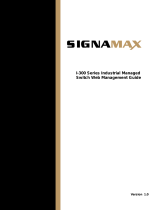
11.3.3 Action Create ................................................................................................. 169
11.4 Policy Binding ........................................................................................................... 170
11.4.1 Binding Table ................................................................................................. 170
11.4.2 Port Binding ................................................................................................... 171
11.4.3 VLAN Binding ................................................................................................. 171
11.5 Application Example for ACL .................................................................................... 172
Chapter 12 Network Security ...................................................................................................... 175
12.1 IP-MAC Binding ........................................................................................................ 175
12.1.1 Binding Table ................................................................................................. 175
12.1.2 Manual Binding .............................................................................................. 177
12.1.3 ARP Scanning ................................................................................................ 178
12.1.4 DHCP Snooping ............................................................................................. 179
12.2 ARP Inspection ......................................................................................................... 185
12.2.1 ARP Detect .................................................................................................... 189
12.2.2 ARP Defend ................................................................................................... 190
12.2.3 ARP Statistics ................................................................................................ 191
12.3 DoS Defend .............................................................................................................. 192
12.4 802.1X ...................................................................................................................... 194
12.4.1 Global Config ................................................................................................. 198
12.4.2 Port Config ..................................................................................................... 200
12.4.3 Radius Server ................................................................................................ 201
Chapter 13 SNMP ....................................................................................................................... 204
13.1 SNMP Config ............................................................................................................ 206
13.1.1 Global Config ................................................................................................. 206
13.1.2 SNMP View .................................................................................................... 207
13.1.3 SNMP Group .................................................................................................. 208
13.1.4 SNMP User .................................................................................................... 209
13.1.5 SNMP Community.......................................................................................... 211
13.2 Notification ................................................................................................................ 213
13.3 RMON ....................................................................................................................... 215
13.3.1 History Control ............................................................................................... 216
13.3.2 Event Config .................................................................................................. 216
13.3.3 Alarm Config .................................................................................................. 217
Chapter 14 Cluster ...................................................................................................................... 220
14.1 NDP .......................................................................................................................... 221
VII





















